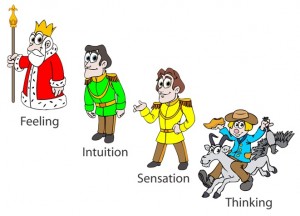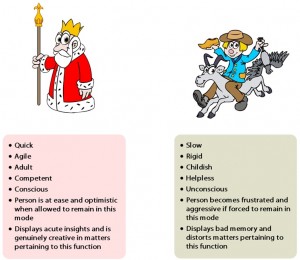John Barlow is a contributing guest writer for CelebrityTypes. As always with guest writers on the site, Barlow’s piece represents his own insights and assessments and not necessarily those of the site. In this piece, Barlow attempts an informal and colloquial exposition of basic function theory.
By John Barlow
In my last article, I talked about the functions. I also put up some disclaimers about my articles not being academic, which are still in effect. In this article, I’m going to talk about the difference between dominant and inferior functions, and I’m going to be stealing — uhm, I mean paraphrasing — a lot of stuff from a student of Jung’s called Marie-Louise von Franz (you can read more about her stuff here).
The Four-Function Model
Okay then. According to the Jungian model, each type has four functions. Now, a lot of people don’t understand the difference between a function and an orientation that we covered in Part 1, so they mistakenly think there’s eight functions. That’s kind of like saying that something that’s located in a three-dimensional space must really be six-dimensional because you don’t understand the difference between a dimension and a point within a dimension. A lot of people also mistakenly think that a function is a like a skill. And so they reason that if you don’t “have” a particular function, you can’t perform a particular task. “Without Extroverted Sensation, you wouldn’t be able to drive a car,” they say.
So some theorists have attempted to fix Jung’s “omission” by making a model where the whole type has eight functions (instead of the original four). These theorists have fixed Jung’s omission in the same way that a friend’s toddler once fixed my electrical socket with a table knife.
As we’ve seen, there are not eight functions, but four. It may be true that driving a car requires Sensation, but every type has Sensation. Since there are only four functions, every type has all the functions. What they don’t have is every function with every orientation.
The Arrangement of the Functions
So let’s put the knife down and stay with the classic four-function model. It’s really quite neat. In fact, it’s like in the fairy tales (I mean the real ones, not Disney): There’s a king and his three sons. Two of them are some real smooth Prince Charming types, and they’re the oldest, but there’s also the third son who is the youngest, and who is generally an imbecile. Let’s call him Numbskull.
In our model, the king is the dominant function: He rules the psyche, while the smooth Prince Charming types are the auxiliary (2nd) and tertiary (3rd) functions. They don’t really have much of a personality because they’re just doing what princes are supposed to be doing; they’re subservient to the king, eager to find some gold-digging princess, start a family and carry on the king’s lineage. Yawn. But Numbskull Jack is our anti-hero: He is the one who, besides, having a personality of his own, can also teach the king something about himself. The princes of gloss could never do that: They’re too eager to please dad.
So what would an ENFJ look like under the four-function model? Well, here’s an illustration:
Okay, so it’s Feeling, Intuition, Sensation, and Thinking in that order. Therefore we can only be dealing with ENFJ or — POP QUIZ! — one other type. Can you guess which one?
If you really are new to this stuff, you probably can’t. That’s completely okay though. It’s kind of like someone’s in the fourth grade and then his teacher just decides to give him an eighth grade puzzle, because the teacher is a douche. I’m not a douche, so you can see the answer here.
The Inferior and Dominant Functions
So now we’ve learned that there’s some tension between the king and the Numbskull. In an ENFJ, Feeling is the king and Thinking is the Numbskull. But depending on the type, any function can be the king, and any function can be the Numbskull. No matter which function is the king and the Numbskull, though, those functions will always have some specific characteristics simply because they are the king and the Numbskull:
We’ve just said that any function can be the king and any function can be the Numbskull. That’s true, but it doesn’t mean that you get to pick freely among all of the possible options. You can’t have Feeling as the king and Intuition as the Numbskull, for example, for as we saw in Part 1 of this series, Feeling, Intuition, and Sensation tend to work together, just like the king can count on the two first-born Prince Charming types to do his bidding. Only the Numbskull gets in the way of his plans. So who is the Numbskull? As Jung said in §694 of Psychological Types, the inferior function is always of an opposite nature and direction to the dominant function. So if Feeling is the king, Thinking will always be the Numbskull, and if that Feeling is extroverted, the Numbskull Thinking will always be introverted.
The same goes for the rest of the types. The possible combinations are therefore like this:
The Eagle and the Mouse
The relation between the king (dominant) and the Numbskull (inferior) will be like the relationship between an eagle and a mouse. Since the inferior function is our clumsy antihero with a will of its own, it will be quite uncomfortable for the person to try and engage it. It will be much easier for them to fall back on the king who is competent and reliable. The dominant function is a like a proud eagle, majestically cruising the skies, smug from its own savvy. The inferior function is like a timid mouse, running for cover at the first sign of a threat.
 So when the person is confronted with a problem that might conceivably engage the insecure little mouse, the first impulse is to shift one’s response so as to let the dominant function take the wheel in place of the mouse. The eagle swoops down, “better let a professional handle this.”
So when the person is confronted with a problem that might conceivably engage the insecure little mouse, the first impulse is to shift one’s response so as to let the dominant function take the wheel in place of the mouse. The eagle swoops down, “better let a professional handle this.”
For example, say Fe is the king, and our ENFJ is asked: “So what do you think of the way the USA took care of bin Laden? Do you think they just have the right to barge into another sovereign nation like that? And what about a trial — shouldn’t he have had one?” Then (in our example, at least) the ENFJ cannot access their timid Numbskull mouse Ti then and there — they’d have to be in a safe and quiet environment to do that, and to be able to go slow, so that the inferior function (which resides in the unconscious) may gradually seep up into consciousness. Then our ENFJ could work out what they really think of the way the USA took care of bin Laden, through engaging their Ti and all.
But most of the time, that’s not what happens. It’s much more commonplace to simply have the eagle take over from the mouse. In this example, Fe would take over for Ti, by answering something commonplace and generally accepted; an answer that is likely to satisfy to person who posed the question, but which is not an expression of the ENFJ’s true thoughts on the matter at all.
Of course, this goes for all of the types, not just the ENFJ. Most of the time, people don’t even realize that they are doing it. And for Thinking types, where Feeling is the Numbskull, it’s sometimes even worse. Confronted with a Feeling challenge, they might be taken in by cheesy and vapid expressions of Feeling, or fall back on standardized and impersonal expressions of Feeling, which have nothing to do with the Thinking type’s true Feeling. Something that’s agreed to communicate a certain strand of Feeling (like 12 red roses and a box of chocolates), but which is not authentic or enriched by the Thinking type’s personal qualities. Just like the Feeling type borrowed general idioms of Thinking to avoid engaging his inferior function, so the Thinking type does the same for Feeling (and Intuition types do the same for Sensation, while Sensation types do the same for Intuition, of course).
***
When people hear about the clumsy state of their inferior function they always think that means that they should just go flex it some more, as if it were a matter of getting swole at the mental gym. But the people who think that are precisely the people who have not understood that the inferior function resides in the unconscious and thus cannot be approached through normal consciousness. One must acknowledge its presence and allow it its space. Like Jesus said in the gospels, give to Caesar what is Caesar’s and give to God what is God’s. The unconscious has a right to exist without you attempting to control it directly.
ACKNOWLEDGEMENTS
- A lot of the points in this article were taken from Marie-Louise von Franz.
- The picture with the eagle and mouse was drawn by Will Rosales.
- The pictures with the princes and king were drawn by Georgios Magkakis.



